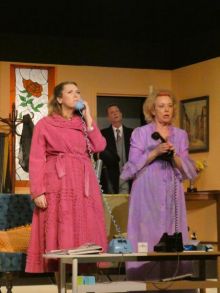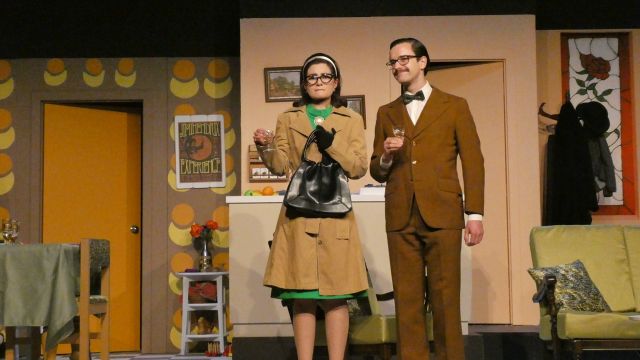How the Other Half Loves
Ayckbourn is a self-professed social commentator of his time. His plays reflect that he is a keen observer of people. Two of his favourite themes, marriage and social class, form the framework of How the Other Half Loves. Written in 1969, this play, in fact, is known to have secured his success as a playwright. Ayckbourn himself commented, "I like to deal in the basics – marriage; it's so tragic and comic, you know - the things people can do to each other. Or the way the rich and the poor do things.”
Galleon Theatre Group’s production of the play is directed by Warren McKenzie and is a farce about three couples from distinctly different classes. It follows the consequences of an adulterous, not entirely believable affair between Fiona Foster, played by Joanne St Clair and Bob Phillips, portrayed as a rough, east end-style Londoner by Andy Steuart. Fiona is the philandering wife of Phillips’ boss Frank and in Fiona and Bob’s attempt to cover their tracks, a third, younger couple, the Featherstones, are unwittingly roped in as cover for the pair’s duplicity.

The older couple, Frank and Fiona Foster, are the holders of both the wealth and the power. Andrew Clark as Frank has arguably found his metier in farce. Clark’s character is reminiscent of a young John Cleese, absent-minded, dithering and gullible. His cut glass accent is flawless, his timing is impeccable and he is entirely believable as a duped upper class husband. His experience as an actor shows and he steals every scene he is in.
St Clair is a skilled and seasoned performer. Her performance is confident and nuanced; her accent is clipped and reflective of her social position and her timing, essential in a farce, is excellent.
As Bob and Teresa Phillips, Andy Steuart and Leanne Robinson have the least sympathetic roles. Together, their accents falter and, at times, become a caricature. On her own, Robinson confidently sells her role as the frequently wronged wife. Steuart is the morally wrong villain and his mysoginistic behaviour, representing the sexism still prevailing in the 1960’s, is not consistently convincing and in this instance, costuming issues for him in terms of pants, jacket and shoes, ie too contemporary/not representative of the period, don’t help. Often, modern audiences need support to understand a different social milieu and this is a challenge for Steuart and this cast as well as this play in these times. There is balance and believability between the Fosters and the Featherstones as married couples. It is less so with the Phillips’ marriage.
Aled Proeve plays the very controlling, eager to please William Featherstone with confidence and attention to maintaining both his character and accent believably. His work at the shared dinner party, where five of the characters hold two dinner parties simultaneously, shows a sophisticated understanding of the comedy timing needed. In fact, everyone does a laudable job of that scene. It is a great audience pleaser.
 As Mary Featherstone, Brittany Daw is a talented and ambitious young performer who uses posture, accent, voice and gesture to create a nervous, reticent woman, accidentally and blissfully unaware (as in all good farces); becoming the focus of the marital indiscretion.
As Mary Featherstone, Brittany Daw is a talented and ambitious young performer who uses posture, accent, voice and gesture to create a nervous, reticent woman, accidentally and blissfully unaware (as in all good farces); becoming the focus of the marital indiscretion.
Daw has also undertaken the design of a complex and well-dressed set that cleverly puts two apartments into one room, adding to the farcical interplay and making it seamless and believable. The use of the set by all actors is excellent. Movement between place and time is fluid and is, at times, complex for the actors.
Music, sound and lighting support this production well. The stage looks interesting and is well used with thoughtful directing ensuring that the audience sees two totally different apartments in one appropriately furnished room. This adds to both the humour and audience fun and the actors use this to great effect, seemingly oblivious of each other as part of the visual humour.
Balance and inter-relatedness is important with farce as it creates enough belief to believe the ridiculous. In this production, it works less well between the couples when they interact. Having said that, the dialogue had very good pace for most of the opening night performance with all of the actors confidently delivering the performance of this complex, nuanced farce.
Galleon’s production is an audience pleaser, and a timely reminder that to survive being a liar, you need to be really good at it.
Jude Hines
Subscribe to our E-Newsletter, buy our latest print edition or find a Performing Arts book at Book Nook.

